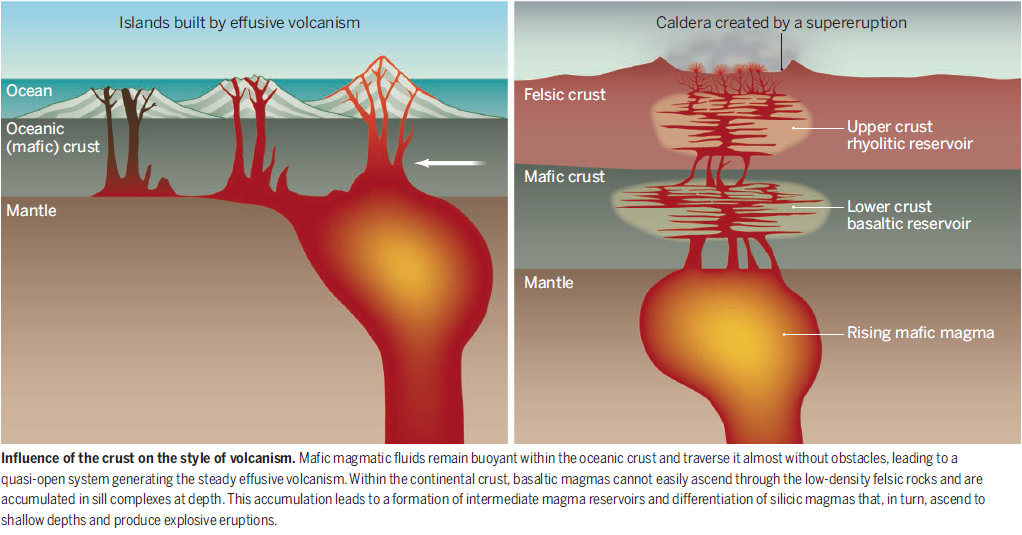В разделе INSIGHTS | PERSPECTIVES журнала «Science» опубликована статья Николая Шапиро и Ивана Кулакова "Probing the underbelly of a supervolcano", в которой российские ученые комментируют исследование одного из крупнейших активных континентальных вулканических образований - Йеллоустоунского супервулкана – The Yellowstone magmatic system from the mantle plume to the upper crust by Hsin-Hua Huang, Fan-Chi Lin, Brandon Schmandt, Jamie Farrell, Robert B. Smith, and Victor C. Tsai.
Наряду с исследлованием супервулкана Тоба (о.Суматра), выполненным авторами ранее (A large magmatic sill complex beneath the Toba caldera by K. Jaxybulatov, N. M. Shapiro, I. Koulakov, A. Mordret, M. Landès, C. Sens-Schönfelder) результаты сейсмической томографии коры и верхних слоев мантии под Йеллоустоунским вулканическим полем позволяют лучше понять картину суперизвержений.
Seismic imaging of Yellowstone provides a better understanding of large volcanic systems
ByNikolai M. Shapiro andIvan Koulakov
Human civilization remains vulnerable to volcanic eruptions. For example, the moderate eruption of Eyjafjallajokull volcano in Iceland in 2010 was responsible for the total disruption of air traffic in Europe for several days. The largest eruptions known in human history (such as that of Mount Tambora, Indonesia, in 1815) ejected enormous volumes of volcanic material, ranging from 25 to 150 km3, and caused serious worldwide climate changes, leading to huge loss of life even in countries located far from volcanoes. Even greater eruptions that have spewed out more than 1000 km3 of ash and volcanic gases into the atmosphere have occurred in the recent geological past (1). The ash of such supereruptions covered huge areas, polluted the atmosphere, and caused notable climate changes throughout the world with marked effects on the biosphere (2). Evaluating whether such strong volcanic eruptions will occur in the future requires an understanding of the geological processes and physical mechanisms that led to them. Such an understanding can be gained from studies of the volcanic systems known to produce these supereruptions in the near past. On page 773 of this issue, Huang et al. (3) present a new seismic tomography study of the crust and the uppermost mantle beneath the Yellowstone volcanic field that provides insights into the functioning of supervolcanoes.
Located in North America, this volcanic system is the youngest manifestation of the Yellowstone hotspot (4,5) and is among the most active supervolcanic sites of the Quaternary period [the other two are Toba in Indonesia (2) and Taupo in New Zealand (6)]. It is characterized by extensive earthquake activity, episodic ground deformation, high fluxes of heat and CO2 emission, and a vigorous hydrothermal system. The Yellowstone complex is made of large cal- deras generated by several explosive eruptions. The three largest eruptions occurred 2.1 million years ago (Ma), 1.3 Ma, and 640,000 years ago, forming the Island Park caldera, the Henry's Fork caldera, and the Yellowstone caldera, respectively. The Island Park caldera supereruption produced the Huckleberry Ridge Tuff and was the largest with ~2500 km3 of ejected material. The younger Henry's Fork caldera is associated with the smaller Mesa Falls Tuff (~280 km3). The latest supereruption formed the Yellowstone caldera and produced the Lava Creek Tuff (~1000 km3).
In comparison, volcanoes fed by the Hawaii hotspot have erupted ~300,000 km3 of lava in the past 5.5 Ma (7). Despite the larger output rate compared to Yellowstone, these volcanoes did not generate appreciable explosive eruptions and are characterized by a relatively steady sequence of many thousands of effusive eruptions.
Both the Hawaii and the Yellowstone volcanoes are fed by mafic melts generated in the mantle. Therefore, the reason(s) for the striking difference in their styles of volca- nism is not related to the deepest magma sources but must be sought in the structures through which magma passes on its way to the surface. In the case of Hawaii, the hot basaltic melts rise through a thin and mostly mafic oceanic crust in which they remain relatively buoyant, leading to a fast ascent directly to the surface (see the figure) and an effusive volcanism dominated by basaltic lava flows.

Magma ascent through thick continental crust proceeds in more complex ways. Basaltic melts are denser than most of the felsic rocks that make up the upper crust. They therefore tend to stall within the lower or middle crust, where they form magma reservoirs that grow over many thousands or a few millions of years (8) by accretion of many individual sills (9,10). Silicic magmas that are enriched in volatiles and cause explosive eruptions are believed to be produced by magma differentiation during the long-term evolution of these crustal reservoirs (11).
In most cases, the information about the origin and evolution of these crustal mag- matic reservoirs is deduced from petrological analysis of the erupted volcanic rocks, though their location and size remain poorly known.
Huang et alls seismic tomography survey of deep parts of the Yellowstone volcanic system combined local and teleseismic data. This information allowed them to unveil a 46-km3 basaltic reservoir in the lower crust that is a factor of about 4.5 times larger than a shallower rhyolitic reservoir. This lower-crustal reservoir absorbs a large part of the magmas generated by the mantle plume, and only a reduced volume of evolved magmas ascends to the surface and generates large explosive eruptions. The results of Huang et al. show that further understanding of the functioning of the largest volcanic systems requires information about their roots in the lower crust that can be obtained via large-scale geophysical studies, including seismic and magnetotelluric (12) imaging.
REFERENCES AND NOTES